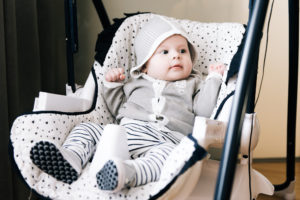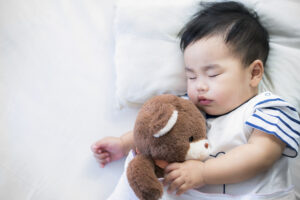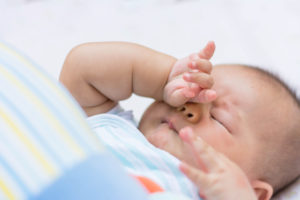When you buy through our links, we may earn a commission. Products or services may be offered by an affiliated entity. Learn more.
Babies and Sleep
An overview about how babies sleep and ways to help them get the rest they need
A baby’s first year of life is filled with a great number of milestones. Sleeping through the night on a regular basis may be one that parents look forward to the most.
It can take some time for parents to adjust to a new baby’s sleep routine and learn how to help ensure their baby is getting a healthy amount of sleep. It’s natural to have questions about what is considered normal sleeping habits and what changes might occur over the first 12 months of your child’s life.
How Much Sleep Do Babies Need?
Sleep patterns will change over the first year of a baby’s life, including the number of hours of sleep needed and the duration of sleep periods throughout the day and night .
- 0 to 4 months: Sleep needs of newborns vary widely and can range from as few as 11 hours to as many as 19 hours in a 24-hour day, broken into shorter periods to accommodate feeding, diaper changes, and interaction with their family. Parents shouldn’t worry if their newborn’s sleep pattern doesn’t match the projections, as these amounts can vary before the first four months.
- 4 to 6 months: Starting at around 4 months of age, an infant’s daily sleep needs drop to 12 to 16 hours. Around this time, sleep also starts consolidating into longer periods as babies are able to go longer without feeding. Sometime during this period is when most babies start to sleep through the night, though there are exceptions to the rule.
- 6 to 12 months: From 6 months onward, babies do the bulk of their sleeping at night. However, other issues such as teething, growth spurts, illnesses, or sleep regressions may start leading to nighttime awakenings. Parents may opt to use more specific sleep-training strategies if babies aren’t sleeping through the night at this stage.
Sleep is essential for human development. During sleep the brain experiences intense activity, building the foundations for how we learn and grow, including developing our behavior, emotions, and immune system. Poor sleep in infancy has been linked to problems with cognitive performance, social skills, obesity, and quality of life later in childhood.
Your baby will usually tell you they’re ready to sleep by fussing, crying, yawning, or rubbing their eyes. You can use these cues to establish a schedule that works for them. Deviating significantly from these recommendations may have adverse effects on your baby’s health or indicate an underlying problem.
A realistic goal is to help your baby sleep consecutively throughout the night by the time they reach their first birthday. As they grow into toddlers and school-age children, their sleep needs will become more similar to those of adults.
Help Your Baby Sleep Better With Pediatric Sleep Coaching

our partner at sleepdoctor.com
Learn More“Life-changing! My anxiety about my son’s sleeping habits were immediately reduced after talking to Sara. She went above and beyond to tailor a schedule to our goals, answer our questions, keep us on track, and check in to encourage us when we just thought we couldn’t do it anymore.”
Rachael B. – Verified Customer
How To Help Your Baby Get To Sleep (and Stay Asleep)
Setting a consistent routine is key to helping your baby learn to sleep through the night. During the first few months, your baby’s sleep schedule will largely be dictated by their eating pattern. However, as they grow, they’ll be able to go longer and longer between feedings. At this point, you can start to adhere to a day-night schedule.
To help your baby establish a healthy circadian rhythm, start by making sure your baby gets plenty of daylight and stimulation during the day. While young infants need several naps during the daytime, you can experiment to find a napping schedule that makes your baby tired enough to sleep at night without being overtired. In the lead-up to bedtime, try to set a calming atmosphere and carry out the same bedtime routine every night. The following rituals can help your baby associate nighttime with sleeping:
- Taking a bath (only if it’s not too stimulating for the child)
- Changing into pajamas and a fresh diaper
- Reading a book
- Singing a lullaby
- Having a nighttime feed (but being sure the child does not fall asleep at the breast or bottle)
- Giving a goodnight kiss
- Dimming the lights
- Turning down the thermostat by 1-3 degrees
- Creating a quiet environment
An important part of developing healthy sleeping habits for your baby includes teaching them to fall asleep on their own . Many babies find it soothing to be rocked or cuddled, but it’s best to put your baby to bed before they actually fall asleep. This way they will be less anxious if they wake up during the night and you are not there, and they will be more likely to fall back asleep without needing your help.
What To Do if Your Baby Isn’t Sleeping Well
Every baby is different, so don’t fret if your baby isn’t following all the rules. While it’s normal for newborns to wake up multiple times throughout the night, don’t hesitate to talk to your pediatrician if you have questions about your baby’s sleep patterns.
If your baby wakes up crying and doesn’t fall back asleep after a few minutes, they might be hungry, uncomfortable, or need their diaper changed. Quickly and quietly take care of their needs, using a nightlight instead of the overhead light if possible. Using a lamp with a red light bulb is beneficial for infants in the newborn period because they cannot see the red light waves but the caregiver can see clearly to change the diaper or feed. You may soothe an anxious baby by patting them or saying a few reassuring words, but try not to take them out of the crib unless it’s strictly necessary.

Giving your baby plenty of love and attention during the day and encouraging them to be independent at night may ease the separation anxiety that many babies start to feel around the 6-month mark. Your baby may also feel more comfortable with a pacifier.
It’s not uncommon for babies to revert to an erratic sleep schedule occasionally. These sleep regressions are a normal (and often temporary) part of healthy infancy and can happen due to teething, illness, growth spurts, changing nap times, or when they are learning new skills such as how to talk or walk.
If you’re a new parent, you’ll know firsthand how difficult it is to soothe a baby to sleep when you yourself are feeling sleep-deprived. Many caregivers find that the best time to grab a few winks is when the baby is sleeping, even if this means napping during the day. Don’t be afraid to reach out to family and friends for help taking care of the baby if you feel overwhelmed.

Still have questions? Ask our community!
Join our Sleep Care Community — a trusted hub of sleep health professionals, product specialists, and people just like you. Whether you need expert sleep advice for your insomnia or you’re searching for the perfect mattress, we’ve got you covered. Get personalized guidance from the experts who know sleep best.
References
6 Sources
-
Kirsch, D. (2022, September 12). Stages and architecture of normal sleep. In S. M. Harding (Ed.). UpToDate.
https://www.uptodate.com/contents/stages-and-architecture-of-normal-sleep -
Paruthi, S., Brooks, L. J., D’Ambrosio, C., Hall, W. A., Kotagal, S., Lloyd, R. M., Malow, B. A., Maski, K., Nichols, C., Quan, S. F., Rosen, C. L., Troester, M. M., & Wise, M. S. (2016). Recommended Amount of Sleep for Pediatric Populations: A Consensus Statement of the American Academy of Sleep Medicine. Journal of clinical sleep medicine : JCSM : official publication of the American Academy of Sleep Medicine, 12(6), 785–786.
https://pubmed.ncbi.nlm.nih.gov/27250809/ -
Henderson, J. M., France, K. G., Owens, J. L., & Blampied, N. M. (2010). Sleeping through the night: the consolidation of self-regulated sleep across the first year of life. Pediatrics, 126(5), e1081–e1087.
https://publications.aap.org/pediatrics/article/126/5/e1081/65212/Sleeping-Through-the-Night-The-Consolidation-of -
A.D.A.M. Medical Encyclopedia. (2020, October 2). Bedtime habits for infants and children. MedlinePlus., Retrieved October 26, 2020, fromA.D.A.M. Medical Encyclopedia. (2018, October 11). Bedtime habits for infants and children.
https://medlineplus.gov/ency/article/002392.htm -
Gradisar, M., Jackson, K., Spurrier, N. J., Gibson, J., Whitham, J., Williams, A. S., Dolby, R., & Kennaway, D. J. (2016). Behavioral Interventions for Infant Sleep Problems: A Randomized Controlled Trial. Pediatrics, 137(6), e20151486.
https://publications.aap.org/pediatrics/article/137/6/e20151486/52401/Behavioral-Interventions-for-Infant-Sleep-Problems -
A.D.A.M. Medical Encyclopedia. (2018, May 20). Separation anxiety in children., Retrieved October 26, 2020, from
https://medlineplus.gov/ency/article/001542.htm




























